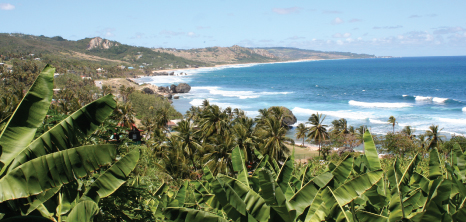|
Baobab TreeThe Baobab tree (Adamsonia digitata) is originally from Africa and is also called the Monkey Bread tree as people of Barbados refer to it as such based on the peculiar looking fruit that it bears. In Africa, it is also called the Tree of Life as it becomes hollow once mature and as a result offers the capacity to provide food, shelter and water for animals and humans alike.
The Baobab tree has the amazing ability to survive in not so fertile soil because of the phenomenal water-storage capacity of its trunk and its expansive horizontal root systems, which are able to gather any available surface moisture. It is known for its longevity which is said to span over a period of approximately 1000 years.
Amidst all the other islands in the Caribbean, Barbados holds the enviable position of being the only island in the Caribbean to be home to two of these magnificent trees. One tree can be found in Queen's Park on the outskirts of Barbados' capital city, Bridgetown, in the parish of St. Michael and the other tree can be found at Warrens in St. Michael.
Barbados has a profusion of historical sites that are very responsible for making the island a unique treasure. As visitors travel throughout the world in an effort to discover and experience, we in Barbados are proud to be a part of our very own unique experience.
The Seven Wonders of the World was historically listed as being seven sites known to the Ancient Greeks as the most impressive spots in their known world. In the Barbados Tourism Encyclopedia, the Seven Wonders of Barbados is historically listed as seven sites on the island that are seen as most impressive. Interestingly enough, the two awe-inspiring specimens of the Baobab trees that can be found on the island at Queen's Park and Warrens, have made it into this encyclopedia.
CharacteristicsThe Baobab sheds its leaves annually in the dry season. It has a rather unusually swollen, short, trunk and root-like branch formations. At the end of these root-like branch formations, clusters of palmately compound leaves can be found.
The flowers are 4-5 in across and have waxy crinkled petals about 4 in long that surround dense clusters of purplish stamens that look like powder puffs. The flowers open only at night and are pollinated by bats feeding on the nectar. The pendant fruits are velvet covered, gray and gourdlike, about a foot long, and apparently look like dead rats hanging from the tree by their tails.
Baobab Tree at Queen's ParkThe more than two hundred and fifty (250) year old Baobab tree in Queen's Park has a trunk that measures approximately fifty-five (55) ft in circumference, making it the larger of the two trees on the island of Barbados.
Baobab Tree at WarrensSaid to be brought from Guinea in 1738, this tree at Warrens is a source of attention as visitors can be seen offloading tour buses just to capture a unique piece of Barbados' history.
Medicinal Value of the Baobab TreeThe fruit of the Baobab tree contains naturally dehydrated fruit pulp with essential amino acids that provide a great source of energy. The fruit of the Baobab tree is rich in vitamins A, B1, B2, B6, C and calcium and possesses an overflowing amount of anti-oxidants. The vitamin C content is six (6) times higher than that of an orange and the mineral content includes calcium, phosphorus, potassium, iron, sodium, zinc and magnesium. It is said that the calcium content is even higher than a glass of milk. The Baobab pulp is quite versatile and can be used to make juices, energy drinks, smoothies, ice creams, fruit powders, chewable tablets and cereal bars. The functions of the colon and intestines are regulated through the dietary and soluble fibers it provides.
The leaves are used for flavouring food and medicinal purposes. The seed endocarp (the innermost layer of the pericarp that surrounds a seed in a fruit) has naturally occurring Omega 3, 6 and 9.
The seed oil, leaves and bark can serve well in the cosmetic industry to make creams, masks, shampoos, conditioners, lotions and exfoliants. The seeds can be pressed to extract oil used for cooking and the cork-like bark can be used to make rope and cloth.
In generall, the wide range of usage of the Baobab tree makes it a highly valuable natural resource. Here's hoping that in Barbados we see this tree as much more than an amazingly huge tree but also 'embrace' it for its deeper purposes.
|



